#alois senefelder
Explore tagged Tumblr posts
Text
Milestone Monday

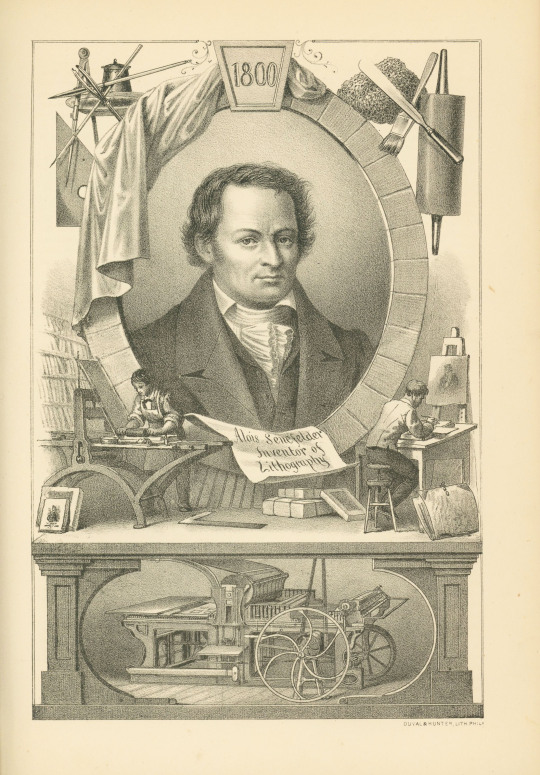
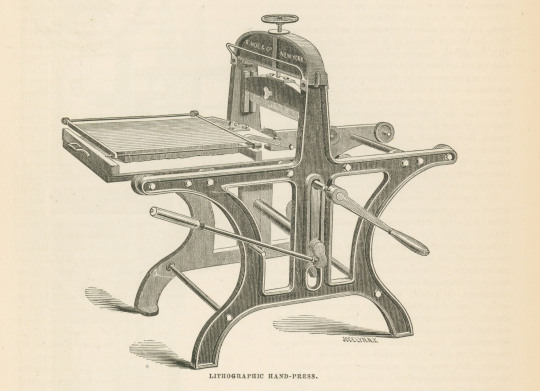
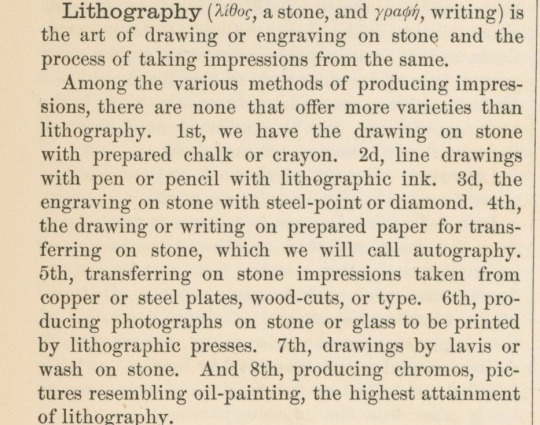

On this day, November 6, 1771, Alois Senefelder (1771-1834) inventor of lithography was born. The son of an actor and tasked with supporting his mother and siblings after his father’s death, Senefelder began his own acting career at age twenty and extended his occupational talents into playwriting. Unable to afford to publish a new play he’d written, Senefelder experimented with what he called “stone printing” in the 1790s, etching acid resistant ink onto limestone and subsequently inventing the first planographic process in printing. Senefelder perfected the chemical process and designed a special printing press with the help of the André family and within five years lithography was being used as a cheap form of creating reproductions by publishers and in mapmaking by land surveying offices throughout Europe.
By the early 1800’s Senefelder and his contemporaries were thinking of ways to introduce color to lithography. Senefelder outlined his ideas on chromolithography in his 1818 book A Complete Course of Lithography, but it was Godefroy Engelmann of France who was awarded the patent for it in 1837.
In celebration of Senefelder’s birthday and all that he contributed to the printing world; we’re looking at the American Encyclopedia of Printing published in 1871 by Menamin & Ringwalt of Philadelphia. Included within the section on lithography is a storied portrait of Senefelder surrounded by his tools and accomplishments. The lithographic portrait was printed by Duval & Hunter, lithographers and chromo publishers out of Philadelphia.
It wasn’t long before artists saw the appeal of lithographs and began taking advantage of the new printing technique. Lithography was far more approachable than other printing methods of the time like engraving, because artists could draw directly on the stone with familiar tools, such as pens and crayons. They did not need to master a new medium or skill to create highly accurate prints with deep textural qualities.
Among the artists of the 1800’s diving into lithography, Honoré-Victorin Daumier (1808-1879) excelled in the medium. Daumier was a prolific French artist who created more than 4,000 lithographs in addition to his many sculptures, paintings, drawings, and wood engravings. His specialty was satirical social caricatures of Parisian life where he effortlessly blended artistry, social commentary, and humor as showcased in the following lithographs held within our collection. The prints were published in 1840 by La maison Aubert of Paris.
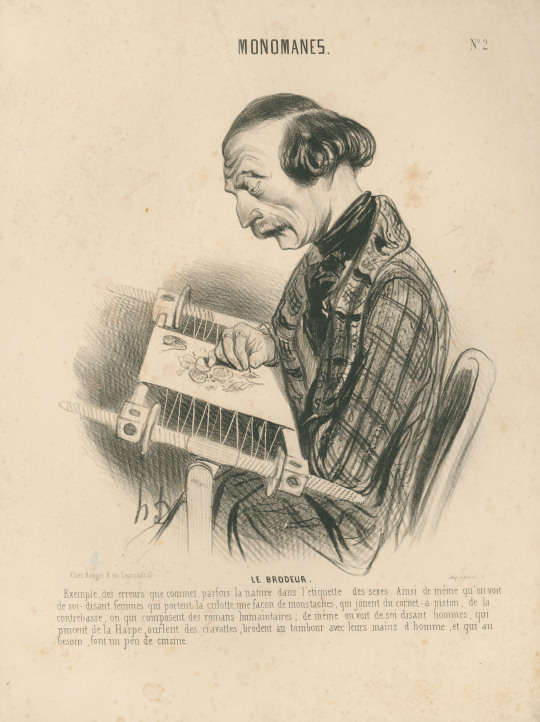

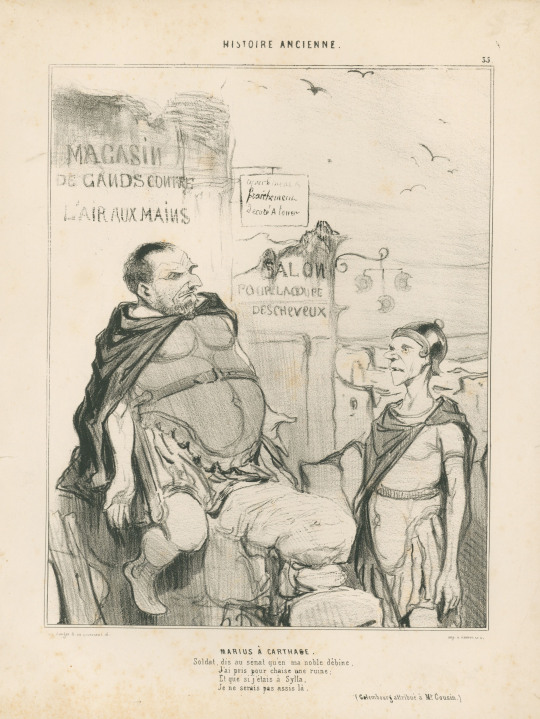


View other posts from the American Encyclopedia of Printing.
View more posts with lithographs.
View more Milestone Monday posts.
– Jenna, Special Collections Graduate Intern
#Milestone Monday#milestones#alois senefelder#lithography#planographic printing#J. Luther Ringwalt#American Encyclopedia of Printing#Menamin & Ringwalt\#Duval & Hunter#Honoré-Victorin Daumier#Daumier#La maison Aubert#lithographs#inventions
19 notes
·
View notes
Text

Work in progress
(one ♥️)
#work in progress#woop woop#limestone#alois senefelder#kuipie#kuipiedekat#lithografie#lithograph#litho
1 note
·
View note
Text

Aaaaaaaa, Cynthia Spiering..... Spierimg
0 notes
Text


reconstruction of Archaeopteryx
Archaeopteryx fossil - Berlin specimen
Paleontologists have long thought that Archaeopteryx ('ancient feather' or 'ancient wing') fossils placed the dinosaur at the base of the bird evolutionary tree. Recent evidence suggests the beast may be best described as a birdlike dinosaur rather than an early bird, though it probably could fly after a fashion. Archaeopteryx is about 150 million years of age, while the ancestor of all living birds lived sometime in the Late Cretaceous — 50 to 65 million years ago.
In 1861, the first Archaeopteryx skeleton, which was missing most of its head and neck, was unearthed near Langenaltheim, Germany. However, the most complete skeleton, the Berlin Specimen, was discovered in 1874 or 1875 near Eichstatt, Germany by farmer Jakob Niemeyer, who sold it in 1876 to innkeeper Johann Dörr. Through various transactions, the fossil, which is the first found to have an intact head, eventually wound up being in the Humboldt Museum fur Naturkunde, where it still resides. To date there have been 11 other Archaeopteryx fossils found, the latest discovered in 2010 (described in 2014). All of the fossils come from the limestone deposits near Solnhofen. Recent tests performed on the specimens indicate that the primary coloring of the feathers of Archaeopteryx were black, possibly with lighter colored tips.
Jurassic deposits of Solnhofen limestone in southern Germany are marked by rare but exceptionally well preserved fossils of many species. It was first quarried nearly 2,000 years ago by the Romans who used the stone for paving roads and building walls. In later Roman times the mosaic floor of the church of Hagia Sofia in Istanbul was made of this limestone. In the Middle Ages, the stone was also used as floor and roofing material, and artisans used the material in the making of bas-relief sculptures and headstones. A decisive turning point in the history of the stone was the determination in 1673 by Alois Senefelder that the dense, fine-grained material was ideally-suited for use in the newly discovered printing process of lithography, a use that caused quarrying to increase dramatically.
25 notes
·
View notes
Photo
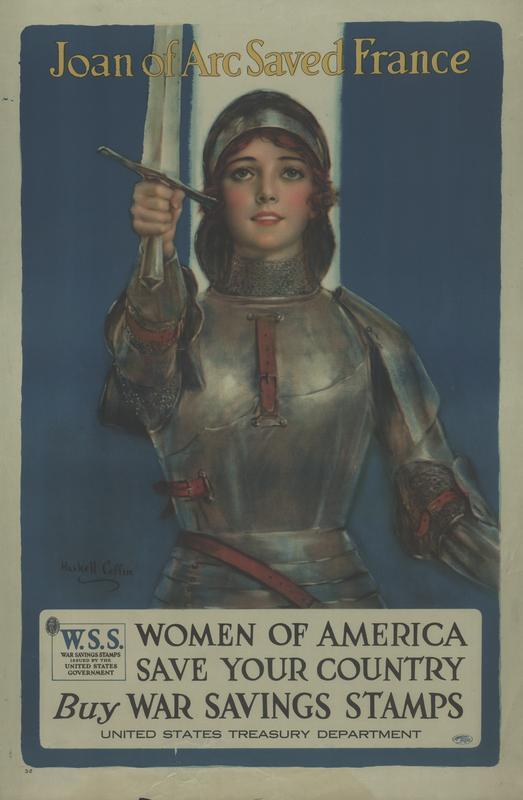
#WordyWednesday
Lithography: An illustration process invented in 1798 by Alois Senefelder that is neither intaglio nor relief. Lithography involves writing on a flat surface with a grease-crayon and then applying an acid solution to slightly etch the non-drawn surfaces. The entire surface is then covered in water, which does not lie on the greasy marks (as water and grease repel one another). A greasy printing ink is then applied, which only settles on the greasy drawing, and can then be printed. Lithography can be done using special limestones or using metal plates. It allows color printing in a way that previous illustration techniques did not and is still practiced by artists today.
Image: Coffin, Haskell, 1878-1941. Joan of Arc saved France: women of America save your country. New York: United States Printing & Lithographic Co., 1918?. D522.25 .C64 1918. Digitally available at the MU Digital Library.
(via Jobbing — Lithography · Rare Books: A Glossary · Special Collections and Archives)
#printing history#printmaking#lithography#wordy wednesday#wordywednesday#john henry#special collections#specialcollections#rare books#rarebooks#bookhistory#poster#posters#world war i#great war#joan of arc#wwi
31 notes
·
View notes
Text
Holidays 11.6
Holidays
All the Good Things Wrapped Up in One Day
Arbor Day (Republic of Congo, Samoa)
Bank Workers’ Day (Argentina)
Constitution Day (Dominican Republic, Tajikistan)
Electric Razor Day
Fala Day
Fill Our Staplers Day
Finnish Swedish Heritage Day
Flag Day (Chad, Finland)
Global Refill Day
Green March Day (Morocco, Western Sahara)
Gustavus Adolphus Day (Sweden)
Hydrogen Bomb First Test Day
International Day For Preventing the Exploitation of the Environment in War & Armed Conflict (UN)
International End Gossip Day
International Tracksuit Day
Legalization Day (Cannabis)
Malaria Day in the Americas
Marching Band Day
Marijuana Recreational Legalization Day (Colorado, Washington)
Marooned Without a Compass Day
Measure Up Day
National Basketball Day (a.k.a. Play Basketball Day)
National I Read Canadian Day (Canada)
National Ladies Learning Code Day (Canada)
National Michele Day
National Report Home Health Care Fraud Day
National Stacey Abrams Day
National Team Manager Day
Obama Day (Kenya)
Pine Nut Day (French Republic)
Recreational Cannabis Legalization Day (Colorado)
Saxophone Day
Scotchtoberfest (The Simpsons)
Skirret Day (French Republic)
Stranger Things Day
Tazaungdaing (Myanmar)
United Americas Day
World Cee-C Day (Nigeria)
World Lets Stop Shouting Awareness Day
World Materials Day
World Paper Free Day
Food & Drink Celebrations
Do Tater Tots Ever Grow Up? Day
Global Donut Day
National Nachos Day (a.k.a. I Love Nachos Day)
Peanut Butter Lovers Day
Independence & Related Days
Constitution Day (Tajikistan)
Cycoldia (Declared; 2018) [unrecognized]
Day of the First Shout For Independence (El Salvador)
Mexico (Independence Declared; 1813)
Polish Republic (Declared; 1918)
1st Wednesday in November
Eat Smart Day [1st Wednesday]
Hump Day [Every Wednesday]
International Pathology Day [1st Wednesday]
International Stress Awareness Day [1st Wednesday]
Men’s World Day [1st Wednesday]
National Advent Calendar Day [1st Wednesday]
National Eating Healthy Day [1st Wednesday]
National Holiday Calendar Day [1st Wednesday]
National Stress Awareness Day (UK) [1st Wednesday]
Take Our Kids to Work Day (Canada) [1st Wednesday]
Wacky Wednesday [Every Wednesday]
Website Wednesday [Every Wednesday]
Wheat Beer Wednesday [1st Wednesday of Each Month]
Wilderness Wednesday [1st Wednesday of Each Month]
Wobbly Wednesday [1st Wednesday]
Weekly Holidays beginning November 6 (1st Full Week of November)
None Known
Festivals Beginning November 6, 2024
Dublin Book Festival (Dublin, Ireland) [thru 11.10]
Hawai'i Food & Wine Festival (Oahu, Hawaii) [thru 11.10]
Jazz Fest Sarajevo (Sarajevo, Bosnia and Herzegovina) [thru 11.9]
Stockholm International Film Festival (Stockholm, Sweden) [thru 11.17]
Worlds of Flavor International Conference and Festival (Napa Valley, California) [thru 11.8]
Feast Days
Adelaide of Italy (Christian; Saint)
Albert Camus (Writerism)
Alois Senefelder (Artology)
Barlaam of Khutyn (Christian; Saint)
Birth of the Bab (Baha'i) [1 Muharram]
Birth of Tiamat (Ancient Egyptian mother of gods, goddess of primeval chaos)
Burroughs Day (Church of the SubGenius; Saint)
Cosimo de Medici the Elder (Positivist; Saint)
Dabucuri uiga, (Initiation Rites of the Young Men; to Jurupari, South American Guarani/Tupi God)
Demetrian (Christian; Saint)
Dodo Grieving Day (Pastafarian)
Feast of All Saints of Ireland (Ireland)
Festival of Total Submission
Herne’s Day II: Predator (Pagan)
Illtud (a.k.a. Illtyd or Iltntus; Christian; Saint)
Illitud’s Bell (Celtic Book of Days)
Learn a New Swear Word Day (Pastafarian)
Leonard of Noblac (Christian; Saint) [Coopers] *
Los Posadas (Latin America) [until 12.24]
Lucy Jones (Muppetism)
Melaine of Rennes (Christian; Saint)
Misa de Gallo begins (Rooster’s Mass; Philippines) [until 12.24]
Stephanie Vozzo (Artology)
Tiamat the Dragon Mother Day (Everyday Wicca)
Winds of Change Day (Starza Pagan Book of Days)
Winnoc (Christian; Saint)
Wish-Granting Championships (Fairies; Shamanism)
Lucky & Unlucky Days
Sakimake (先負 Japan) [Bad luck in the morning, good luck in the afternoon.]
Tycho Brahe Unlucky Day (Scandinavia) [33 of 37]
Uncyclopedia Bad to Be Born Today (because it’s National Day to Lose Money on Horses.)
Unglückstage (Unlucky Day; Pennsylvania Dutch) [26 of 30]
Unlucky Day (Grafton’s Manual of 1565) [51 of 60]
Premieres
All Along the Watchtower, recorded by Bob Dylan (Song; 1967)
And Then There Were None, by Agatha Christie (Mystery Novel; 1939) [29]
Behind Blue Eyes, by The Who (Song; 1971)
The Boondocks (Animated TV Series; 2005)
Chew Chew Baby or Stick to Your Gums (Rocky & Bullwinkle Cartoon, S4, Ep. 175; 1962)
A Cowboy Needs a Horse (Disney Cartoon; 1956)
Cry Freedom (Film; 1987)
Elizabeth (Film; 1998)
The Flea Circus (Tex Avery MGM Cartoon; 1954)
Forget-Me-Net, Parts 3 & 4 (Underdog Cartoon, S2, Eps. 31 & 32; 1965)
Foxtrot, by Genesis (Album; 1972)
Go Down Mooses or The Fall Guy (Rocky & Bullwinkle Cartoon, S2, Ep. 70; 1960)
Harry Potter and the Goblet of Fire (Film; 2005) [#4]
Head (Film; 1968)
Hiding Out (Film; 1987)
Hold What You’ve Got, by Joe Tex (Song; 1964)
Ickle Meets Pickle (Terrytoons Cartoon; 1942)
Jersey Boys (Broadway Musical; 2005)
John Wesley Harding, recorded by Bob Dylan (Song; 1967)
Justify My Love, by Madonna (Album; 1990)
Kitty Caddy (Phantasies Cartoon; 1947)
Less Than Zero (Film; 1987)
Little Good Beep (WB LT Cartoon; 2000)
The Little Match Girl (Color Rhapsody Cartoon; 1937)
Little Red Walking Hood (WB MM Cartoon; 1937)
Made in Heaven, by Queen (Album; 1995)
Meet the Press (TV Series; 1947)
The Missing Mountain or Peek-a-Boo Peak (Rocky & Bullwinkle Cartoon, S2, Ep. 69; 1960)
The Moon Fell in the River, by Guy Lombardo (Song; 1940)
Paper Doll, by The Mills Brothers (Song; 1943)
Passenger 57 (Film; 1992)
Pisces, Aquarius, Capricorn & Jones Ltd., by The Monks (Album; 1967)
Precious (Film; 2009)
Rain of Terror or The Desperate Showers (Rocky & Bullwinkle Cartoon, S4, Ep. 176; 1962)
The Robot Spy (Animated TV Show;Jonny Quest #8; 1964)
Secrets of Life (Short Documentary Film; 1956)
Ski-Napper (Chilly Willy Cartoon; 1964)
Sky Trooper (Disney Cartoon; 1942)
Spectre (UK Film; 2015) [James Bond #24]
Spotlight (Film; 2015)
Symphony No. 3 in A Minor, by Sergei Rachmaninoff (Symphony; 1936)
Time Bandits (Film; 1981)
24 (TV Series; 2001)
The Universe in a Nutshell, by Stephen Hawking (Book; 2001)
The Unpopular Mechanic (Oswald the Lucky Rabbit Cartoon; 1936)
An Unsuitable Job for a Woman, by P.D. James (Novel; 1972)
When We Were Very Young, by A.A.Milne (Children’s Book; 1924)
Wintertime Dreams, recorded by Woody Herman (Song; 1936)
Woody’s Kook-Out (Woody Woodpecker Cartoon; 1961)
Your Friend the Rat (Pixar Cartoon; 2007)
The Zoo (Oswald the Lucky Rabbit Cartoon; 1933)
Today’s Name Days
Christina, Leonhard, Rudolf (Austria)
Leonard, Melanija, Sever, Vedran (Croatia)
Liběna (Czech Republic)
Leonhardus (Denmark)
Aadi, Aado, Aadu, Ado, Adolf (Estonia)
Mimosa (Finland)
Bertille, Léonard (France)
Christine, Leonhard, Nina (Germany)
Leonardo (Greece)
Lénárd (Hungary)
Leonardo (Italy)
Leo, Leonards, Leonhards, Leons, Linards (Latvia)
Ašmantas, Leonardas, Vygaudė (Lithuania)
Lennart, Leonard (Norway)
Feliks, Leonard, Trzebowit, Ziemowit (Poland)
Pavel (Romania)
Renáta (Slovakia)
Alejandro, Leonardo, Severo (Spain)
Adolf, Gustav (Sweden)
Mac, Mack, Mackenzie, Makenzie, Mckenzie (USA)
Today is Also…
Day of Year: Day 311 of 2024; 55 days remaining in the year
ISO: Day 3 of Week 45 of 2024
Celtic Tree Calendar: Hagal (Hailstone) [Day 11 of 28]
Chinese: Month 10 (Yi-Hai), Day 6 (Jia-Xu)
Chinese Year of the: Dragon 4722 (until January 29, 2025) [Wu-Chen]
Hebrew: 5 Heshvan 5785
Islamic: 4 Jumada I 1446
J Cal: 11 Wood; Foursday [11 of 30]
Julian: 24 October 2024
Moon: 24%: Waxing Crescent
Positivist: 3 Frederic (12th Month) [Guicciardini / Philippe de Comines]
Runic Half Month: Wyn (Joy) [Day 15 of 15]
Season: Autumn or Fall (Day 45 of 90)
Week: 1st Full Week of November
Zodiac: Scorpio (Day 14 of 30)
2 notes
·
View notes
Text
Research: History of Posters
Posters have existed for a long time in human history; initially appearing as advertisements and announcements in the form of placards and posted bills. They were also used in the form of a block of text. e.g.: announcement/advertisement for Shakespeare's plays.
Lithography was invented in 1796 by Alois Senefelder. This was soon followed by the creation of chromolithiography
A century later (1890s) chromolithography had spread to the rest of Europe. France especially had a number of prolific poster artists which included Henri de Toulouse-Lautrec, Jules Chéret, Eugène Grasset, Adolphe Willette, Pierre Bonnard, Louis Anquetin, the brothers Léon and Alfred Choubrac, Georges de Feure, and Henri-Gabriel Ibels.
Jules Chéret in particular was a renowned pencil artist and scene decorator, who established a small lithography office in Paris in 1866. He made use of striking characters, bold contrasts, and vibrant colors in advertising posters, creating over 1,000 captivating designs for exhibitions, theaters, and various products. His innovative approach attracted numerous aspiring painters, providing a valuable source of income for the burgeoning artistic community.
Chéret revolutionised the art of lithography, developing new techniques that enabled the use of richer, more expressive colors. It was known as Cheret's 3-stone lithographic process. This innovation, combined with his pioneering use of the female form as an advertising tool, though controversial, contributed significantly to the burgeoning popularity of posters. The accessibility and commercial success of posters attracted the attention of fine artists, who increasingly embraced this medium. This growing popularity culminated in a major exhibition of posters held in Paris in 1884, solidifying their place in popular culture.
The emergence of the modern poster can be attributed to several key factors. Firstly, advancements in printing technology, particularly the refinement of color lithography, enabled the mass production of large, high-quality images at an affordable cost. Secondly, the relaxation of government censorship in countries like France allowed for greater freedom of expression in public spaces. Finally, the rise of mass consumerism fueled a growing demand for effective advertising, prompting businesses to seek innovative ways to reach larger audiences. These converging factors laid the groundwork for the development of the modern poster designs that we recognise today.
1890 -1900: The Golden Age and Art Nouveau
In 1891, Toulouse-Lautrec's groundbreaking poster for the Moulin Rouge elevated the medium of poster design to the realm of fine art, igniting a widespread poster craze. The 1890s, known as the Belle Époque in France, witnessed a flourishing of poster culture, with exhibitions, magazines, and art dealers dedicated to this burgeoning art form.
In 1894, Alphonse Mucha, a Czech artist working in Paris, created a groundbreaking poster that is considered the first masterpiece of Art Nouveau. Drawing inspiration from various sources, including the Pre-Raphaelites, the Arts and Crafts Movement, and Byzantine art, this distinctive style, characterized by its flowing lines, organic forms, and decorative motifs, quickly gained international prominence and dominated decorative arts until the outbreak of World War I.
Artists like Théophile Steinlen, Albert Guillaume, Leonetto Cappiello, and Henri Thiriet further expanded the boundaries of poster art, contributing to its growing influence. These talented individuals not only created captivating advertisements but also used posters as a powerful medium for social and political commentary.
Posters emerged as a powerful reflection of each nation's unique cultural identity. In France, they celebrated the vibrant cafe and cabaret culture. Italy embraced the drama of opera and the elegance of fashion, while Spain showcased the passion of bullfighting and the vibrancy of its festivals. Germany championed trade fairs and magazines, while Britain and America celebrated literary journals, the rise of cycling, and the spectacle of the circus.
Despite this cross-cultural exchange, distinct national styles emerged. Dutch posters were characterized by their restraint and orderliness, Italian posters by their dramatic flair and grand scale, and German posters by their directness and often medieval-inspired aesthetic.
1900 - 1914: The Death of Art Nouveau
By the turn of the 20th century, Art Nouveau, despite its initial vibrancy, began to feel stale, its elegant curves and intricate flourishes losing their novelty through over-repetition. The passing of Toulouse-Lautrec in 1901 and the departure of key figures like Mucha and Chéret from the field of poster design further shook the movement.
Into this artistic vacuum stepped Leonetto Cappiello, an Italian caricaturist who arrived in Paris in 1898. Rejecting the ornate excesses of Art Nouveau, Cappiello introduced a bold new aesthetic. His posters, characterised by simple, impactful imagery, often infused with humor or a touch of the bizarre, immediately captivated the public. This focus on visual impact and the creation of instantly recognisable brand identities solidified Cappiello's position as a pioneer of modern advertising. His influence would dominate Parisian poster design for years to come, until the emergence of the Art Deco movement in the 1920s.
Meanwhile, a significant shift was underway in other parts of Europe. Artists in Scotland, Austria, and Germany, dissatisfied with the increasingly formulaic nature of Art Nouveau, began to explore alternative approaches. They rejected the flowing curves and organic forms of Art Nouveau in favor of a more rectilinear and geometric aesthetic, emphasising functionality and a return to simpler forms.
This movement culminated in the emergence of German Plakatstil, a bold new style championed by artists like Lucian Bernhard and Ludwig Hohlwein. Characterised by simplified naturalism, flat colors, and bold shapes, Plakatstil laid the groundwork for a more abstract and modern visual language, paving the way for future developments in graphic design.
1914 - 1919: World War I
World War I transformed the poster from a commercial tool into a potent weapon of propaganda. The conflict ignited the largest advertising campaign in history, as governments desperately sought to mobilize public support. From rallying citizens to enlist and contribute to war bonds to fueling outrage against enemy atrocities and boosting industrial production, posters became indispensable tools for wartime communication.
The United States, for example, produced an astonishing 2,500 unique poster designs and an estimated 20 million individual posters – a staggering number, amounting to nearly one poster for every four citizens. This massive output demonstrates the critical role that posters played in shaping public opinion and mobilizing national support during the war.


1919 - 1938: Modernism and Art Deco
The end of WW1 ushered in the modern art movements of Cubism, Futurism, Expressionism, and Dadaism, which heavily influenced poster design.
The emergence of formal graphic design education in France, Germany, and Switzerland marked a pivotal shift, elevating the field beyond mere illustration and firmly establishing it as a distinct discipline within advertising. This evolution rapidly influenced the Soviet Union, where the Constructivist movement embraced art as a tool for social and political change.
Constructivist artists, including El Lissitsky, Rodchenko, Klutsis, and the Stenberg Brothers, developed a dynamic "agitational" style characterised by bold diagonals, dynamic photomontage, and jarring color schemes. This revolutionary aesthetic, with its emphasis on bold forms and social impact, exerted a profound influence on Western poster design, particularly through the Bauhaus and De Stijl movements.
By the mid-1920s, these diverse modernist influences began to coalesce, culminating in the rise of Art Deco. This "machine age" style celebrated speed, power, and technological advancement, characterised by streamlined shapes, simplified forms, and a rejection of the flowing curves of Art Nouveau in favor of sleek, angular typography. While distinctly modern, Art Deco also incorporated elements from 'exotic' cultures, drawing inspiration from the arts of Persia, Egypt, and Africa.
The 1925 Decorative Arts Exposition in Paris served as a showcase for this burgeoning movement. Replacing the caricature-driven style of Cappiello, artist A. M. Cassandre introduced a more geometric and intellectual approach, utilising airbrush techniques to create sleek, machine-like imagery. His iconic posters for luxury ocean liners like the Normandie, Statendam, and Atlantique became powerful symbols of the industrial age.
Art Deco, like its predecessor Art Nouveau, quickly spread across Europe and to the United States, solidifying its position as a dominant force in the world of graphic design.
1939 - 1950: The End of Stone Lithography
With WW2, posters once again became a tool for propaganda. By this time, most posters were being made using photo offset. However, the poster played a less pivotal role in the war this time around; mainly due to the rise of radio and print, which proved to be more useful modes of communication with the general public. Furthermore, the rise of television posed a serious challenge to the poster industry after World War II, leading to a decline in its prominence as an advertising medium.
1950 - 1965: Resurgence
With the end of WWII, the world entered a period of optimism and technological advancement. The early 1950s witnessed a resurgence of poster advertising, giving rise to two distinct aesthetic approaches. The '50s Style' embraced vibrant colors and whimsical imagery, appealing to consumer desires. In contrast, the International Typographic Style prioritised rationality and order, emphasising clean lines and functional design.
1965 - 1972: Modernism and the Civil Rights Movements
The 1960s, an era of social and political upheaval, saw a introduction of pop art. Both the vibrant aesthetic of pop art and the urgent messages of protest movements effectively utilised the poster as a powerful medium for communication and social change.
The excesses of the drug culture and political alienation led to a brief but spectacular Psychedelic Poster craze in the U.S., which recalled the floral excesses of Art Nouveau, the pulsating afterimages of Op-Art, and the bizarre juxtapositions of Surrealism. And the French May Day protests generated a school of propaganda poster that harked back to the Soviet poster and cartoon art.
1970 - 1989: Post-Modernism
The International Style spread beyond Switzerland rapidly and became the leading graphic design style worldwide in the Seventies. By the early Eighties, the style began to give way to the Post Modernists, who sought to break the formal and dogmatic rules of the Swiss Style.
A young teacher in Basel named Wolfgang Weingart led the palace revolt which ushered in today's predominant graphic style loosely known as Post Modern design. Weingart experimented with the offset printing process to produce posters that appeared complex and chaotic, playful and spontaneous - all in stark contrast to his elders' teachings. Weingart's liberation of typography was an important foundation for several new styles, from Memphis and Retro, to the advances now being made in computer graphics.
0 notes
Text
Yayın Grafiği Tasarımı 2024-2025 Final Soruları
Yayın Grafiği Tasarımı 2024-2025 Final Soruları Yayın Grafiği Tasarımı 2024-2025 Final Soruları 1. Litografi baskı tekniği hangi yılda ve kim tarafından icat edilmiştir? A) 1982 – Zuzana Licko B) 1984 – April Geriman C) 1923 – Jan Tschichold D) 1796 – Aloys Senefelder E) 1455 – Johannes Gensfleisch zum Gutenberg Cevap: D) 1796 – Aloys Senefelder Açıklama: Litografi tekniği 1796 yılında Aloys…
0 notes
Text
Origin and Evolution
The modern poster emerged in the mid 19th century, a period marked by significant advancements in printing technology. The invention of lithography by Alois Senefelder in 1796, and its subsequent development into chromolithography, allowed for the mass production of vibrant, colorful images. This technological leap made posters an accessible medium for public communication and advertising.
The Belle Époque and Art Nouveau
The late 19th and early 20th centuries, known as the Belle Époque, were a golden age for poster art. Artists like Jules Chéret, often referred to as the "father of the modern poster," revolutionized the medium with his expressive designs and innovative use of color. Chéret's work not only advertised products and events but also transformed the streets of Paris into open-air galleries.
Another prominent figure, Alphonse Mucha, became synonymous with the Art Nouveau movement. His posters, characterized by intricate lines and stylized figures, especially of women, set a standard for aesthetic appeal in advertising.
Posters as Political and Social Tools
Beyond commercial advertising, posters have played pivotal roles in political and social movements. During times of war and social change, they served as powerful tools for propaganda and public messaging, conveying complex ideas through compelling visuals.
The Digital Age and Contemporary Design
With the advent of digital technology, poster design has undergone a transformation. Modern designers now have access to advanced tools and platforms, allowing for greater experimentation and reach. Despite these technological advancements, the core principles of effective poster design clarity, visual impact, and emotional resonance remain unchanged.
Exploring the history of poster design reveals its dynamic evolution and enduring significance. As I prepare my submission for the Animayo 2025 International Poster Contest, I am inspired to create a design that honors this rich legacy while incorporating contemporary elements. Understanding the past empowers me to contribute meaningfully to the future of poster art.
0 notes
Text
What is Lithography? A Simple Explanation
Lithography, a centuries-old technique, is a planographic printing process that relies on the principle that oil and water don't mix. It involves drawing or painting an image on a flat surface, typically a stone or metal plate. The image is created using a greasy substance, such as crayon, ink, or tusche, which makes the drawn areas receptive to oily ink.

What is Lithography & its Process
Here's a breakdown of the key steps in the lithography process:
Image Creation:
Drawing: The artist directly draws the image onto the plate using a greasy medium.
Photolithography: A photographic process is used to transfer an image onto the plate. A light-sensitive emulsion is applied to the plate, and then exposed to light through a negative of the desired image. The exposed areas become receptive to ink.
Chemical Treatment:
The plate is treated with a chemical solution that desensitizes the non-image areas, making them water-receptive.
Inking and Printing:
The plate is dampened with water, which adheres to the non-image areas.
Oily ink is then applied to the plate. The ink adheres to the greasy image areas, while the water repels it.
The inked image is transferred to paper or another material using a printing press.
The Magic of Lithography
Lithography offers several advantages that have contributed to its enduring popularity:
Versatility: It can be used to create a wide range of artistic styles, from delicate line drawings to bold, expressive works.
Detail and Precision: The process allows for fine details and subtle tonal variations.
Durability: Lithographs can be printed in large quantities without significant loss of quality.
Artistic Expression: Lithography has been embraced by many renowned artists as a medium for self-expression and experimentation.
Historical Significance
Lithography was invented in 1796 by German author and actor Alois Senefelder. Initially used for printing music scores and maps, it quickly gained popularity among artists and publishers. The technique revolutionized printmaking, making it more accessible and affordable.
Modern Applications
While traditional lithography is still practiced by artists today, the principles of the process have been adapted for various modern applications:
Offset Printing: This widely used printing technique is based on lithography. It involves transferring the image from a plate to a rubber blanket, and then to the paper.
Photolithography: This process is crucial in the semiconductor industry for creating intricate circuit patterns on silicon wafers.
Digital Lithography: Digital imaging technology has enabled the creation of digital lithographs, where images are directly transferred to plates using computer-controlled laser systems.
Lithography continues to be a valuable tool for artists and industries alike, offering a unique blend of tradition and innovation. Its ability to produce high-quality prints with intricate detail and artistic expression ensures its enduring legacy in the world of printmaking. Sources and related content
0 notes
Text
Holidays 11.6
Holidays
All the Good Things Wrapped Up in One Day
Arbor Day (Republic of Congo, Samoa)
Bank Workers’ Day (Argentina)
Constitution Day (Dominican Republic, Tajikistan)
Electric Razor Day
Fala Day
Fill Our Staplers Day
Finnish Swedish Heritage Day
Flag Day (Chad, Finland)
Global Refill Day
Green March Day (Morocco, Western Sahara)
Gustavus Adolphus Day (Sweden)
Hydrogen Bomb First Test Day
International Day For Preventing the Exploitation of the Environment in War & Armed Conflict (UN)
International End Gossip Day
International Tracksuit Day
Legalization Day (Cannabis)
Malaria Day in the Americas
Marching Band Day
Marijuana Recreational Legalization Day (Colorado, Washington)
Marooned Without a Compass Day
Measure Up Day
National Basketball Day (a.k.a. Play Basketball Day)
National I Read Canadian Day (Canada)
National Ladies Learning Code Day (Canada)
National Michele Day
National Report Home Health Care Fraud Day
National Stacey Abrams Day
National Team Manager Day
Obama Day (Kenya)
Pine Nut Day (French Republic)
Recreational Cannabis Legalization Day (Colorado)
Saxophone Day
Scotchtoberfest (The Simpsons)
Skirret Day (French Republic)
Stranger Things Day
Tazaungdaing (Myanmar)
United Americas Day
World Cee-C Day (Nigeria)
World Lets Stop Shouting Awareness Day
World Materials Day
World Paper Free Day
Food & Drink Celebrations
Do Tater Tots Ever Grow Up? Day
Global Donut Day
National Nachos Day (a.k.a. I Love Nachos Day)
Peanut Butter Lovers Day
Independence & Related Days
Constitution Day (Tajikistan)
Cycoldia (Declared; 2018) [unrecognized]
Day of the First Shout For Independence (El Salvador)
Mexico (Independence Declared; 1813)
Polish Republic (Declared; 1918)
1st Wednesday in November
Eat Smart Day [1st Wednesday]
Hump Day [Every Wednesday]
International Pathology Day [1st Wednesday]
International Stress Awareness Day [1st Wednesday]
Men’s World Day [1st Wednesday]
National Advent Calendar Day [1st Wednesday]
National Eating Healthy Day [1st Wednesday]
National Holiday Calendar Day [1st Wednesday]
National Stress Awareness Day (UK) [1st Wednesday]
Take Our Kids to Work Day (Canada) [1st Wednesday]
Wacky Wednesday [Every Wednesday]
Website Wednesday [Every Wednesday]
Wheat Beer Wednesday [1st Wednesday of Each Month]
Wilderness Wednesday [1st Wednesday of Each Month]
Wobbly Wednesday [1st Wednesday]
Weekly Holidays beginning November 6 (1st Full Week of November)
None Known
Festivals Beginning November 6, 2024
Dublin Book Festival (Dublin, Ireland) [thru 11.10]
Hawai'i Food & Wine Festival (Oahu, Hawaii) [thru 11.10]
Jazz Fest Sarajevo (Sarajevo, Bosnia and Herzegovina) [thru 11.9]
Stockholm International Film Festival (Stockholm, Sweden) [thru 11.17]
Worlds of Flavor International Conference and Festival (Napa Valley, California) [thru 11.8]
Feast Days
Adelaide of Italy (Christian; Saint)
Albert Camus (Writerism)
Alois Senefelder (Artology)
Barlaam of Khutyn (Christian; Saint)
Birth of the Bab (Baha'i) [1 Muharram]
Birth of Tiamat (Ancient Egyptian mother of gods, goddess of primeval chaos)
Burroughs Day (Church of the SubGenius; Saint)
Cosimo de Medici the Elder (Positivist; Saint)
Dabucuri uiga, (Initiation Rites of the Young Men; to Jurupari, South American Guarani/Tupi God)
Demetrian (Christian; Saint)
Dodo Grieving Day (Pastafarian)
Feast of All Saints of Ireland (Ireland)
Festival of Total Submission
Herne’s Day II: Predator (Pagan)
Illtud (a.k.a. Illtyd or Iltntus; Christian; Saint)
Illitud’s Bell (Celtic Book of Days)
Learn a New Swear Word Day (Pastafarian)
Leonard of Noblac (Christian; Saint) [Coopers] *
Los Posadas (Latin America) [until 12.24]
Lucy Jones (Muppetism)
Melaine of Rennes (Christian; Saint)
Misa de Gallo begins (Rooster’s Mass; Philippines) [until 12.24]
Stephanie Vozzo (Artology)
Tiamat the Dragon Mother Day (Everyday Wicca)
Winds of Change Day (Starza Pagan Book of Days)
Winnoc (Christian; Saint)
Wish-Granting Championships (Fairies; Shamanism)
Lucky & Unlucky Days
Sakimake (先負 Japan) [Bad luck in the morning, good luck in the afternoon.]
Tycho Brahe Unlucky Day (Scandinavia) [33 of 37]
Uncyclopedia Bad to Be Born Today (because it’s National Day to Lose Money on Horses.)
Unglückstage (Unlucky Day; Pennsylvania Dutch) [26 of 30]
Unlucky Day (Grafton’s Manual of 1565) [51 of 60]
Premieres
All Along the Watchtower, recorded by Bob Dylan (Song; 1967)
And Then There Were None, by Agatha Christie (Mystery Novel; 1939) [29]
Behind Blue Eyes, by The Who (Song; 1971)
The Boondocks (Animated TV Series; 2005)
Chew Chew Baby or Stick to Your Gums (Rocky & Bullwinkle Cartoon, S4, Ep. 175; 1962)
A Cowboy Needs a Horse (Disney Cartoon; 1956)
Cry Freedom (Film; 1987)
Elizabeth (Film; 1998)
The Flea Circus (Tex Avery MGM Cartoon; 1954)
Forget-Me-Net, Parts 3 & 4 (Underdog Cartoon, S2, Eps. 31 & 32; 1965)
Foxtrot, by Genesis (Album; 1972)
Go Down Mooses or The Fall Guy (Rocky & Bullwinkle Cartoon, S2, Ep. 70; 1960)
Harry Potter and the Goblet of Fire (Film; 2005) [#4]
Head (Film; 1968)
Hiding Out (Film; 1987)
Hold What You’ve Got, by Joe Tex (Song; 1964)
Ickle Meets Pickle (Terrytoons Cartoon; 1942)
Jersey Boys (Broadway Musical; 2005)
John Wesley Harding, recorded by Bob Dylan (Song; 1967)
Justify My Love, by Madonna (Album; 1990)
Kitty Caddy (Phantasies Cartoon; 1947)
Less Than Zero (Film; 1987)
Little Good Beep (WB LT Cartoon; 2000)
The Little Match Girl (Color Rhapsody Cartoon; 1937)
Little Red Walking Hood (WB MM Cartoon; 1937)
Made in Heaven, by Queen (Album; 1995)
Meet the Press (TV Series; 1947)
The Missing Mountain or Peek-a-Boo Peak (Rocky & Bullwinkle Cartoon, S2, Ep. 69; 1960)
The Moon Fell in the River, by Guy Lombardo (Song; 1940)
Paper Doll, by The Mills Brothers (Song; 1943)
Passenger 57 (Film; 1992)
Pisces, Aquarius, Capricorn & Jones Ltd., by The Monks (Album; 1967)
Precious (Film; 2009)
Rain of Terror or The Desperate Showers (Rocky & Bullwinkle Cartoon, S4, Ep. 176; 1962)
The Robot Spy (Animated TV Show;Jonny Quest #8; 1964)
Secrets of Life (Short Documentary Film; 1956)
Ski-Napper (Chilly Willy Cartoon; 1964)
Sky Trooper (Disney Cartoon; 1942)
Spectre (UK Film; 2015) [James Bond #24]
Spotlight (Film; 2015)
Symphony No. 3 in A Minor, by Sergei Rachmaninoff (Symphony; 1936)
Time Bandits (Film; 1981)
24 (TV Series; 2001)
The Universe in a Nutshell, by Stephen Hawking (Book; 2001)
The Unpopular Mechanic (Oswald the Lucky Rabbit Cartoon; 1936)
An Unsuitable Job for a Woman, by P.D. James (Novel; 1972)
When We Were Very Young, by A.A.Milne (Children’s Book; 1924)
Wintertime Dreams, recorded by Woody Herman (Song; 1936)
Woody’s Kook-Out (Woody Woodpecker Cartoon; 1961)
Your Friend the Rat (Pixar Cartoon; 2007)
The Zoo (Oswald the Lucky Rabbit Cartoon; 1933)
Today’s Name Days
Christina, Leonhard, Rudolf (Austria)
Leonard, Melanija, Sever, Vedran (Croatia)
Liběna (Czech Republic)
Leonhardus (Denmark)
Aadi, Aado, Aadu, Ado, Adolf (Estonia)
Mimosa (Finland)
Bertille, Léonard (France)
Christine, Leonhard, Nina (Germany)
Leonardo (Greece)
Lénárd (Hungary)
Leonardo (Italy)
Leo, Leonards, Leonhards, Leons, Linards (Latvia)
Ašmantas, Leonardas, Vygaudė (Lithuania)
Lennart, Leonard (Norway)
Feliks, Leonard, Trzebowit, Ziemowit (Poland)
Pavel (Romania)
Renáta (Slovakia)
Alejandro, Leonardo, Severo (Spain)
Adolf, Gustav (Sweden)
Mac, Mack, Mackenzie, Makenzie, Mckenzie (USA)
Today is Also…
Day of Year: Day 311 of 2024; 55 days remaining in the year
ISO: Day 3 of Week 45 of 2024
Celtic Tree Calendar: Hagal (Hailstone) [Day 11 of 28]
Chinese: Month 10 (Yi-Hai), Day 6 (Jia-Xu)
Chinese Year of the: Dragon 4722 (until January 29, 2025) [Wu-Chen]
Hebrew: 5 Heshvan 5785
Islamic: 4 Jumada I 1446
J Cal: 11 Wood; Foursday [11 of 30]
Julian: 24 October 2024
Moon: 24%: Waxing Crescent
Positivist: 3 Frederic (12th Month) [Guicciardini / Philippe de Comines]
Runic Half Month: Wyn (Joy) [Day 15 of 15]
Season: Autumn or Fall (Day 45 of 90)
Week: 1st Full Week of November
Zodiac: Scorpio (Day 14 of 30)
0 notes
Text
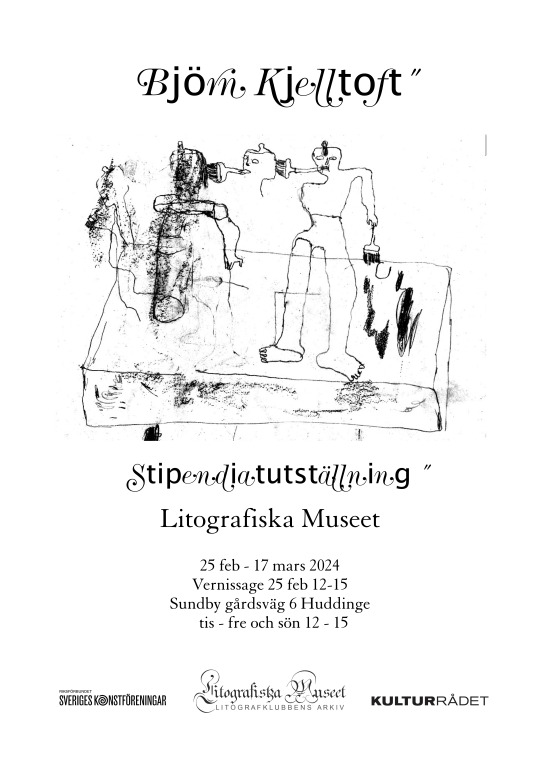
His porcelain eye
Grandfather Ebbe had received his porcelain eye after an accident on his motorcycle from the Birmingham Small Arms Company. It was said that the eye once popped out in the middle of a Christmas gift exchange and to the children's horror, fell straight into Santa's sack.
Among grandfather Ebbe's belongings was a tin box filled with cryptic gadgets and tools. On a canary-yellow box with an elegant label, one could read "Lithographic Crayon No. 1 W. Korn 120 Centre Street New York." I didn't understand the English, but the content was simpler because everyone knows what crayons are for: drawing cowboys with hats and revolvers. But the crayons were specially sticky, sliding around on the paper like a drunken ice skater and leaving streaks blacker than night. This is almost like drawing with licorice sticks, I thought, and gave up...
With the industrial revolution, the supply of consumer goods exploded. Everyday goods, consumables, and capital goods - everything was welcome and people wanted to see their products in worldly packaging and colorful advertisements. Alois Senefelder's invention - the lithographic printing method - fit like a glove in this brave new world. Now one could mass-produce both text and images for a pittance.
Ivar Krüger immediately understood the trend and with safety matches in exotic packages, he conquered half the universe and could build his Xanadu.
Ebbe, on the other hand, parked his motorcycle outside the Gothenburg School of Crafts. With a completed degree, he surfed along with a wave of Swedish lithographers who came to establish themselves during Sweden's interwar period.
Among grandfather Ebbe's works, the cigarette brand Blue Master is a favorite. The package shows a white horse in moonlight and a midnight blue sky. The cigarettes were manufactured by Norway's Tiedemanns Tobaksfabrik. They are still sold today, but instead of visual poetry, they now package the smoke works with black-and-white warning texts.
From the bottom of the 90s financial crisis, mom fished out a small ad in the Göteborgs-Posten.
-Aren't you going to apply to Dômen Art School, Björn?
I applied and got in. In the department for graphic art.
-What is graphic art, mom?
Dômen had the answer but no lithography. It is only now at the Lithographic Museum that I get to grind limestone and drop nitric acid into gum arabic. And for those who haven't already figured it out: those sticky crayons were not meant for children's drawings on paper. The correct substrate is million-year-old limestone from quarries in southern Bavaria. The word lithography, by the way, is a combination of the Greek lithos - stone and graphein - write.
It takes a while for the nitric acid to etch into the stone and then there is a pause in the work. I took the opportunity to look around among the museum's objects and started leafing through a thick old volume. Who do I find there in a sea of black-and-white group photos but grandfather Ebbe in a gray suit. Apparently, at that time, all of Sweden's lithographers dressed like Humphrey Bogart. Imagine that grandfather Ebbe has been there all this time just to be rediscovered in a museum by his grandchild a hundred years later.
With contemporary times deeply immersed in a fondue of popular culture and consumption, it may not be so strange that brands become a recurring theme in one's artistry. But in the background, I also sense impulses from grandfather Ebbe. Being able to spin wheels and rollers in the mighty lithography presses feels a bit like letting circles meet over time and space. It is not just mass-produced products that lithography highlighted in a new way. It was also possible to create a whole new kind of art. Think about it, Ebbe, in a way you are a forerunner to Andy Warhol.
Stipendiary exhibition Lithographic Museum Huddinge, Sweden 2024
0 notes
Video
youtube
Test 6 Modern Tipografi Aykut ilter Tipografi I 6. MODERN TİPOGRAFİ YazdırTüm Cevapları GizleMateryal Listesine Dön ________________________________________ Soru 1: 1827’de Joseph Nicéphore Niépce tarafından ilk kalıcı fotoğraf çekilmiştir. Fotoğrafın bulunuşunun yol açmıştır en önemli gelişme hangisidir? (Çoktan Seçmeli) Dünya olaylarının kaydı açısından devrimsel bir yeniliktir. Çekilen her bir fotoğraf yaşama ve gerçeğe dair tanıklık ve kanıt oluşturmaktadır. Sanat hareketlerinin kendilerini sorgulamalarının önünü açmış, plastik sanatların zamanın belleği olma görevini devralmıştır. Yüzyılın sonuna doğru sinema sanatı gibi önemli gelişmeleri doğurmuştur. ✔ Hepsi Cevap : Hepsi ________________________________________ Soru 2: İngiltere kraliçesi 1837’de taç giymiş olmasına karşın, son yıllarına değin 19. Yüzyıl genel olarak ________ Çağı diye adlandırılır. (Çoktan Seçmeli) Rönesans Barok XIV. Lui ✔ Viktorya Elizabet Cevap : Viktorya ________________________________________ Soru 3: 19. Yüzyıl başında yaygın olarak kullanıma giren yeni sürüm yazı karakteri türü hangisidir? (Çoktan Seçmeli) Face to Face Light Face ✔ Fat Face Baby Face Scarface Cevap : Fat Face ________________________________________ Soru 4: Büyük ölçü ilan, duyuru, afiş, tanıtım kartı ve katalogların başlıklarında kullanılmak üzere 1827’de Darius Wells tarafından tanıtılan el-kesimi hurufat türü hangisidir? (Çoktan Seçmeli) Metal Harfler ✔ Ağaç Harfler Bakır Harfler Gravür Harfler Kağıt Harfler Cevap : Ağaç Harfler ________________________________________ Soru 5: 1840’larda bir sürekli tabakanın ağaçtan kağıt yapımında hayata geçirilen sürekli-rulo kağıt üreten makinasının mucidi kimdir? (Çoktan Seçmeli) ✔ Henry Fourdrinier Austin Burt Friedrich Koenig Andreas Bauer W. H. Fox Talbot Cevap : Henry Fourdrinier ________________________________________ Soru 6: Ağaç veya metal harflerin küçük harf çizimlerinden istenilen büyüklükte (ya da tam tersi) düzgün bir biçimde çizilmesini ve daha sonra kesilmesini mümkün kılan buluş hangisidir? (Çoktan Seçmeli) ✔ Pantograf Litografi Daktilo Sürekli-Rulo Kağıt Fotoğraf Cevap : Pantograf ________________________________________ Soru 7: 18. Yüzyıl sonunda Alois Senefelder tarafından 1796’da bulunan, yağ ve suyun birbirini itme ilkesinden hareketle görüntü aktarımında kullanılan baskı yöntemi hangisidir? (Çoktan Seçmeli) Harf Baskı (Letterpress) ✔ Taş baskı (Litografi) İpek Baskı (Silk Screen) Kalıp Baskı (Ksilografi) Gravür Baskı (Intaglio) Cevap : Taş baskı (Litografi) ________________________________________ Soru 8: 19. Yüzyıl’ın son on yıllarında daha hızlı dizgi yapmak amacıyla geliştirilen, operatör tarafından işletilen bir klavye aracılığıyla yapılan dizginin anında sıcak kurşun dökümünü satır satır üreten tümleşik dizgi aygıtı hangisidir? (Çoktan Seçmeli) Kalotype Monotype ✔ Linotype Intertype Daguerretype Cevap : Linotype ________________________________________ Soru 9: Tarihsel olarak 1860’lardan başlayıp 1910’lara değin etkisini sürdüren Sanatlar ve Elsanatları Hareketi’nin en önemli temsilcisi aşağıdaki sanatçılardan hangisidir? (Çoktan Seçmeli) Fernand Leger Théo van Doesburg El Lissitzky ✔ William Morris Ardengo Soffici Cevap : William Morris ________________________________________ Soru 10: Hangi akım Modernizm akımları içinde yer almaz? (Çoktan Seçmeli) Kübizm Fütürizm Konstrüktivizm Dadaizm ✔ Pre-Raphaelizm Cevap : Pre-Raphaelizm Tipografi,6. MODERN TİPOGRAFİ,Joseph Nicéphore Niépce,ilk kalıcı fotoğraf,1827’de,İngiltere kraliçesi 1837’de taç giymiş,Viktorya,19. Yüzyıl başında,Fat Face,Büyük ölçü ilan,duyuru,tanıtım kartı ve katalogların başlıklarında,Ağaç Harfler,1840’larda bir sürekli tabakanın,kağıt üreten makinasının mucidi,Henry Fourdrinier,Ağaç veya metal harflerin,Pantograf,Taş baskı (Litografi),Harf Baskı (Letterpress),İpek Baskı (Silk Screen),Kalıp Baskı (Ksilografi),Litografi
0 notes
Text
The Historical Evolution of Wedding Invitations: From Town Bellmen to Online Ordering
Weddings have been a celebrated event for centuries, and the practice of inviting guests to witness the union of two souls has evolved significantly over time. Join us on a journey through history as we explore the fascinating process of wedding invitations, from the Middle Ages to the digital age.
Early Roots of Wedding Invitations:
The origins of wedding invitations can be traced back to ancient civilizations. In ancient Egypt, for example, wedding invitations were written on papyrus scrolls, extending an invitation from the bride's family to the groom's family, requesting their presence at the wedding ceremony. Similarly, in ancient Rome, engraved invitations on stone or metal were distributed among the elite to announce upcoming nuptials.
Middle Ages and Before:
In the times preceding the invention of the movable type printing press, wedding announcements in England were made in a unique and communal manner. A Town bellman, or crier, would walk the streets and announce the day's news aloud, including upcoming weddings. This tradition allowed everyone within earshot to be part of the joyous celebration.
However, with ignorance being common among ordinary people in the Middle Ages, the nobility took up the practice of sending written wedding invitations. Wealthy families employed skilled monks, well-versed in the art of calligraphy, to craft these invitations by hand. Such documents often bore the person's coat of arms or personal emblem, and they were sealed with wax for an added touch of elegance.

From 1600 Onward:
The invention of the printing press by Johannes Gutenberg in 1447 brought a new dimension to the world of communication, but the ordinary printing techniques of that time were not suitable for crafting stylish wedding invitations. Nevertheless, the tradition of announcing weddings in newspapers began to take root during this period.
In 1642, Ludwig von Siegen's invention of metal-plate engraving, also known as Mezzotint, made higher-quality wedding invitations accessible to the emerging middle class. Engraving required skilled artisans to reverse-write the text onto a metal plate using carving tools. The resulting invitations were then printed from the plate and protected from smudging by tissue paper—an age-old tradition that continues to this day.
During this era, wedding invitation wordings were more elaborate compared to today's standards, often including the individual names of each guest.

The Industrial Revolution:
The 18th and 19th centuries saw significant advancements in printing technology. The invention of lithography by Alois Senefelder in 1798 allowed for sharper and more distinctive inking without the need for engraving. This innovation paved the way for a true mass-market in wedding invitations.
Despite these printing advancements, the postal system's unreliability still necessitated hand and horseback deliveries of wedding invitations. To protect the delicate invitations en route, a 'double envelope' was used—an enduring tradition that persists to this day.
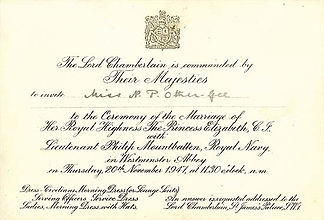
The 20th Century: Modernization and Personalization
Following World War II, the rise of democracy and rapid industrial growth granted the common man the ability to emulate the lifestyles and materialism of society's elite. Notably, prominent figures like Amy Vanderbilt and Emily Post emerged to advise the public on appropriate etiquette, including wedding invitations.
With the development of thermography, wedding stationery became more accessible. Thermography, often called "poor man's engraving," offered a less expensive method of achieving raised type, making both printed and engraved invitations more affordable to a wider audience.
In recent years, letterpress printing has experienced a strong resurgence in popularity for wedding invitations. Its deep impression or "bite" adds a tactile and craft appeal to the printed invitations, providing a unique sensory experience for recipients.
Furthermore, laser engraving has made its mark in the wedding invitation market, particularly for wood veneer, acrylic, and certain types of metal invitations.

Contemporary Trends: Digital Age and Sustainability
In the contemporary era, technology has transformed the wedding invitation landscape. Online ordering has become the latest trend, simplifying the process of viewing, organizing, and ordering wedding invitations. The internet has made it effortless for couples to customize and select their dream wedding invitations from the comfort of their homes.
As we look back at the historical evolution of wedding invitations, it's clear that this tradition has come a long way—from town bellmen and handwritten invitations to the convenience of online ordering. Yet, through the ages, the essence of inviting loved ones to celebrate a couple's special day remains at the heart of this timeless ritual.
The historical process of the wedding invitation exemplifies the evolution of human communication, societal norms, and artistic expression. From the ancient scrolls and medieval parchments to the modern digital age, the journey of the wedding invitation is a testament to the enduring power of love and the desire to share that love with family and friends.
As we move forward into the future, we can expect to see even more innovative ways for couples to announce their weddings. However, no matter how much technology changes, the essence of the wedding invitation will remain unchanged - a heartfelt invitation to celebrate love and unity, bringing people together in joyous harmony.
0 notes
Text
The History Of Lithography
Lithography is a printing technique that has been used for over two centuries. The process involves printing an image from a flat surface onto paper or other materials. Lithography was a significant innovation in the printing industry, as it allowed for the mass production of high-quality images and text. This article will explore the history of lithography, from its invention to its modern-day use.
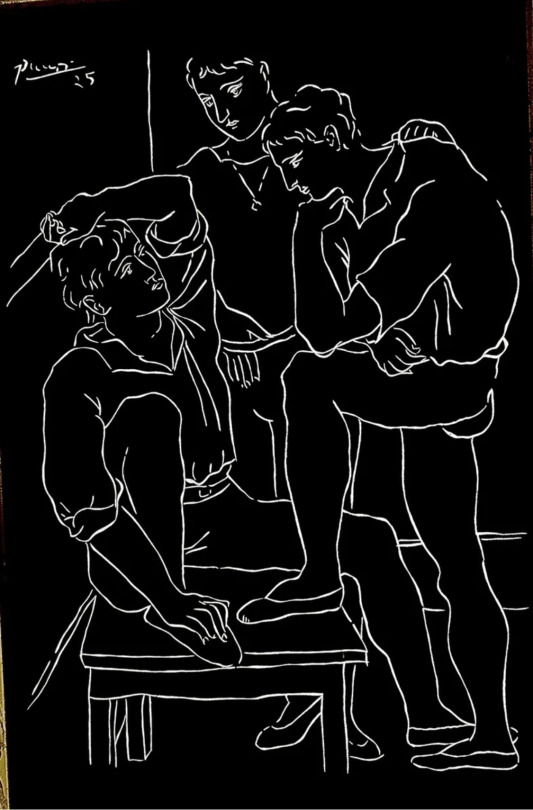
The Invention of Lithography
Lithography was invented in 1796 by Alois Senefelder, a German playwright and actor. Senefelder was struggling to produce copies of his plays, which he had written by hand. He experimented with various printing techniques, including engraving and etching, but found them to be too expensive and time-consuming.
One day, while cleaning a stone slab that he had used to write a script, Senefelder noticed that the grease from his writing had created a visible image on the stone. He realized that he could use this process to create printing plates that could be used to mass-produce copies of his plays.
Senefelder's process involved drawing an image onto a smooth stone surface using a greasy substance, such as a mixture of wax, soap, and lampblack. He then treated the stone with a chemical solution that would fix the image onto the stone surface. The stone was then inked and pressed onto a sheet of paper, creating a printed image.
The Advancement of Lithography
Senefelder's invention quickly gained popularity, as it allowed for the mass production of high-quality images and text. However, the early lithography process was time-consuming and required skilled craftsmen to create the printing plates.
In the early 19th century, new advances in lithography made the process more efficient and accessible. One of the most significant innovations was the development of lithographic presses, which allowed for faster and more consistent printing. The introduction of zinc plates also made it easier to create lithographic printing plates.
Lithography became popular in the art world as well, as artists began to use the process to create prints of their artwork. Many famous artists, such as Francisco Goya and Henri de Toulouse-Lautrec, used lithography to create their prints.
Lithography also became a popular method for printing maps, books, and other materials. The process allowed for the mass-production of high-quality materials, making it an essential tool for businesses and governments.
The Rise of Color Lithography
In the mid-19th century, lithography underwent another significant advancement with the introduction of color printing. The process of color lithography involved using multiple printing plates, each with a different color ink, to create a full-color image.
Color lithography was a significant innovation in the printing industry, as it allowed for the creation of vivid, colorful images. The process was particularly popular in the advertising industry, as companies began to use color lithography to create eye-catching posters and advertisements.
The Modern Use of Lithography
Today, lithography is still a popular printing technique, although it has been largely replaced by digital printing in many applications. However, lithography is still used in many industries, including art, publishing, and packaging.
In the art world, lithography is still used to create prints of artwork. Many artists appreciate the unique qualities of lithography, such as the ability to create bold, textured images. Lithography is also used to create limited edition prints, which are highly valued by collectors.
In the publishing industry, lithography is still used to print books, particularly high-quality art books. Lithography allows for the creation of high-quality images and text, making it an essential tool for producing high-end publications.
Lithography is also used in the packaging industry, particularly for the printing of labels and packaging materials. Lithography allows for the creation of highly detailed and vibrant images, making it an ideal method for creating eye-catching packaging.
In recent years, digital printing has become increasingly popular, and many industries have shifted away from lithography. However, lithography still offers unique benefits, such as the ability to print on a wide range of materials and create textured images.
Conclusion
Lithography has a rich history that spans over two centuries. From its invention by Alois Senefelder in 1796 to its modern-day use in the art, publishing, and packaging industries, lithography has played a significant role in the printing industry.
Senefelder's invention revolutionized the printing industry, allowing for the mass production of high-quality images and text. Advances in lithography technology, such as the development of lithographic presses and color printing, further expanded the capabilities of the process.
Today, lithography is still used in many industries, although it has been largely replaced by digital printing in some applications. However, lithography continues to offer unique benefits, making it an essential tool for creating high-quality prints and packaging materials.
#lithograph#nostalgia#pacasso#fine art#artwork#historical art#collectible#collectables#collection#collectibles#history#nostolgia#art print#art collecting/sales#art collectors#art collection#antiques#antique#vintage style#vintage#vintage art#1950s vintage#1950s style#1950s art#pablo picasso#lithography#enlightenment#abstract art#art deco#art
1 note
·
View note
Text
Jules Chéret (31 May 1836 – 23 September 1932) was a French painter and lithographer who became a master of Belle Époque poster art. He has been called the father of the modern poster.
Lithography (from Ancient Greek λίθος, lithos 'stone', and γράφειν, graphein 'to write') is a planographic method of printing originally based on the immiscibility of oil and water. The printing is from a stone (lithographic limestone) or a metal plate with a smooth surface. It was invented in 1796 by the German author and actor Alois Senefelder and was initially used mostly for musical scores and maps. Lithography can be used to print text or images onto paper or other suitable material. A lithograph is something printed by lithography, but this term is only used for fine art prints and some other, mostly older, types of printed matter, not for those made by modern commercial lithography.
Originally, the image to be printed was drawn with a greasy substance, such as oil, fat, or wax onto the surface of a smooth and flat limestone plate. The stone was then treated with a mixture of weak acid and gum arabic ("etch") that made the parts of the stone's surface that were not protected by the grease more hydrophilic (water attracting). For printing, the stone was first moistened. The water only adhered to the gum-treated parts, making them even more oil-repellant. An oil-based ink was then applied, and would stick only to the original drawing. The ink would finally be transferred to a blank paper sheet, producing a printed page. This traditional technique is still used for fine art printmaking.
In modern commercial lithography, the image is transferred or created as a patterned polymer coating applied to a flexible plastic or metal plate. The printing plates, whether stone or metal, can be created by a photographic process, a method that may be referred to as "photolithography" (although the term usually refers to a vaguely similar microelectronics manufacturing process). Offset printing or "offset lithography" is an elaboration of lithography in which the ink is transferred from the plate to the paper by means of a rubber plate or cylinder, rather than by direct contact of the two. This technique keeps the paper dry and allows high speed fully automated operation. It has mostly replaced traditional lithography for medium- and high-volume printing: since the 1960s, most books and magazines, especially when illustrated in colour, are printed with offset lithography from photographically created metal plates.
As a printing technology, lithography is different from intaglio printing (gravure), wherein a plate is engraved, etched, or stippled to score cavities to contain the printing ink; and woodblock printing or letterpress printing, wherein ink is applied to the raised surfaces of letters or images.
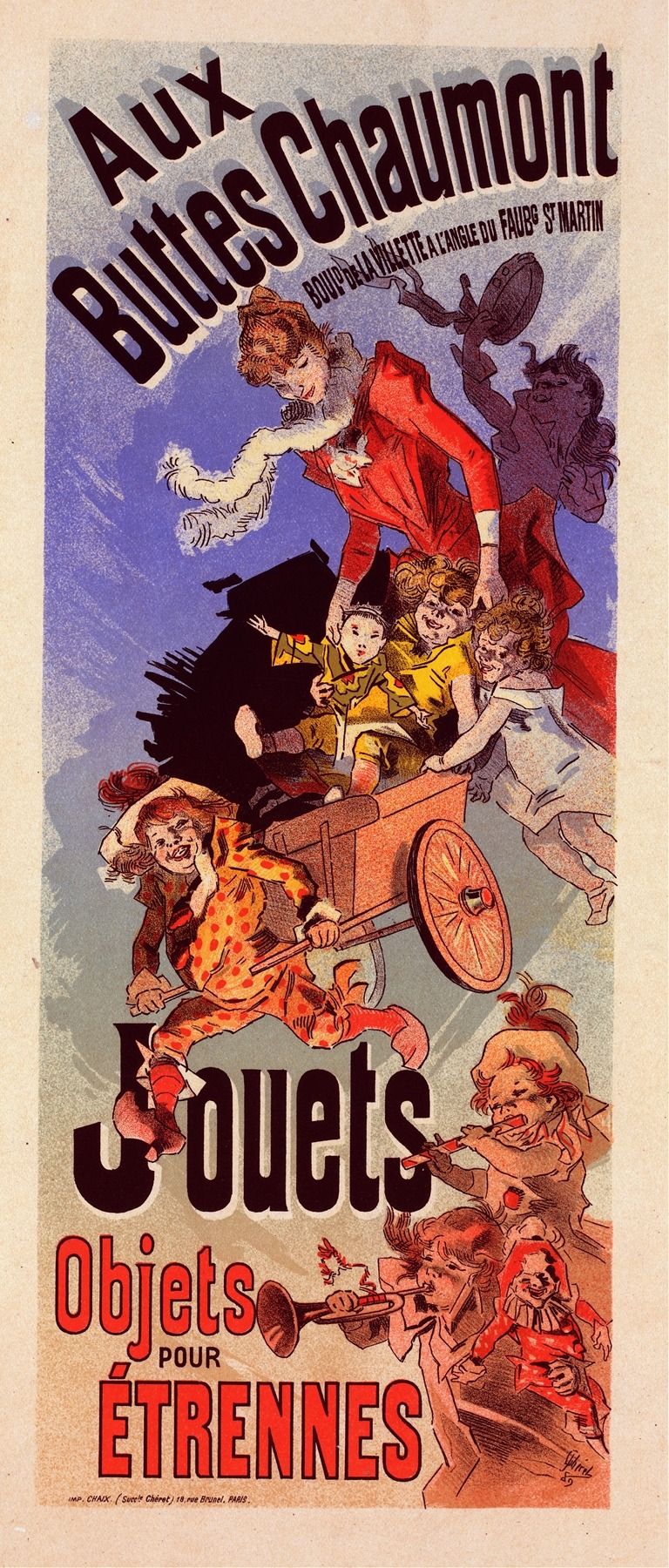
Aux Buttes Chaumont 🧸Jouets
Affiche 🖍🖌de Jules Chéret de 1898
Bel après-midi 👋
50 notes
·
View notes